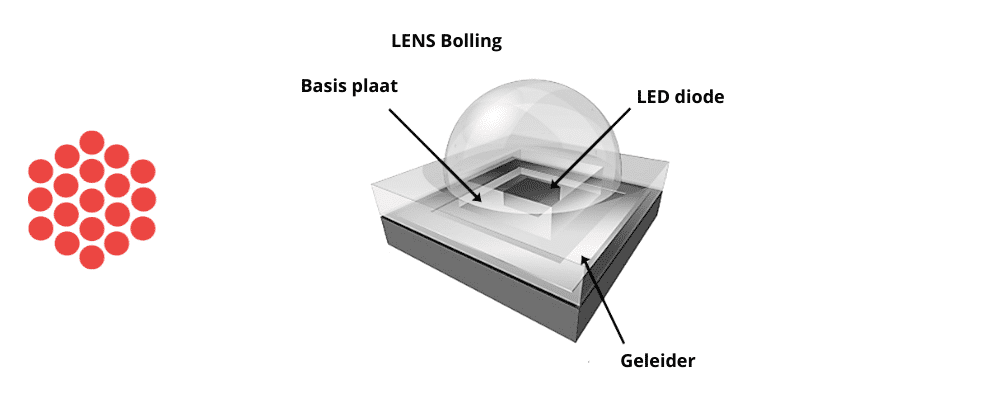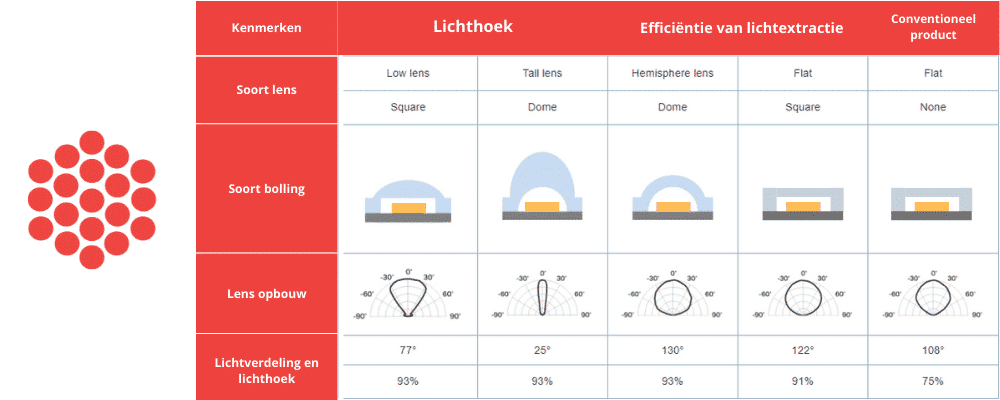An important part of LED lighting is the LED lens. As you probably know from cameras, the lens is sometimes more important than the optical source itself. With LED lighting, you can practically see the same thing. The lens determines how the emitted light is distributed. In other words, it determines the optics of the light. light pattern. Several factors are very important here. The convexity of the lens, the surface area and, of course, the thickness of the glass. The lens in combination with the reflector and the emitted light ensure the distribution and intensity of the light beam.

Different types of LED lenses
See the small protective dome above the diode? This is called the primary optic and helps protect and shape the output of small LED diodes. The light from the LED's primary optics is still too broad for most applications and too weak to illuminate only certain surfaces. Therefore, most LED lamps use secondary optics (lenses, reflectors, TIR optics, etc.) to capture all the light from the LED and increase its intensity. The most common LED lens is the convex lens that is placed around the LED. However, as technology advances, other types of lenses are also becoming more common. There are square lenses, high dome lenses, medium dome lenses and flat lenses. Each with its own light distribution and mounting over the LED diode.
Optical properties of different LED lenses
If you are looking for a specific light image in your LED lighting, it is important to know what kind of lens your lamp uses. To make this clear, we have made a table with the differences.

Bolle lens
De bollere lenzen bij LED’s, zorgen vaak voor een evenredig verdeelde lichtstraal. Ligt de bolling van de lens vlak op de LED chip, dan kun je uitgaan van een vrij evenredig beeld. Is de bollig van de lens hoog en lang? Dan zul je zien dat de lichtstraal meer gefocust is op één specifiek punt. Je kunt hier dan spreken van een gefocust lichtbeeld. Ook de binnenzijde van de lens heeft effect op het uitgestraalde licht. Zo zie je bij een vierkante binnenkant (lage lens, vierkant) een andere lichtverdeling, dan die van de bolle binnenkant. Een voorbeeld van een lamp die gebruik maakt van een vierkante binnenkant gecombineerd met een bolle lens, is de Fish-eye equipped optimus series.
Flat lens
In the same table you can also see that there are two models with a flat lens. This flat lens is found on both the inside and the outside. Because of this you can see that the light distribution is not or hardly affected by the present lens. You can therefore see this as a protection for the LED diode rather than an actual optically changing component.
Is one type of LED lens better than another?
The answer to this is simple: No! A lamp is composed of multiple components that together determine the light pattern. Although the LED lens is crucial for this light pattern, it should always be considered in combination with a reflector or the upper glass. For example, with an LED work lamp, you can use different types of lenses for different applications. The same applies to LED taillights, where the lens, in combination with a distinct color, must emit light. For this reason, an LED lens is not good, bad, or better. Seek advice from specialists if you want to add LED lighting to your machinery.
The materials in LED lenses are different
Since lenses can have different purposes, different materials are used. One of the most common materials is PMMA. By heating this material and using a sturdy mould, this clear, reflective material is easily moulded into the desired shape. When making LED lenses, this has some advantages. The material can also withstand any heat. If you want to equip a sturdy light source that radiates heat with a certain lens, it is handy that this lens does not deform over time and therefore loses the desired light image. Other materials that can be found are polycarbonate and glass. However, these are quite expensive to process in your lighting.